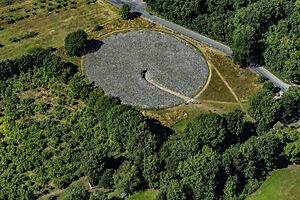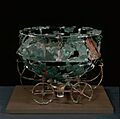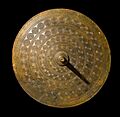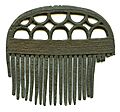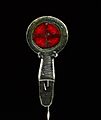Nordic Bronze Age facts for kids
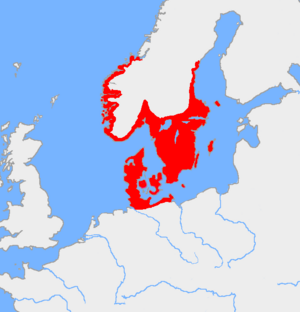 |
|
| Geographical range | Southern Scandinavia, northern Germany |
|---|---|
| Period | Bronze Age |
| Dates | c. 2000/1750–500 BC |
| Preceded by | Battle Axe culture, Bell Beaker culture, Pitted Ware culture, Nordic Stone Age |
| Followed by | Jastorf culture, Pre-Roman Iron Age, Iron Age Scandinavia |
The Nordic Bronze Age (also called the Northern Bronze Age or Scandinavian Bronze Age) was a time in the history of Scandinavia. It lasted from about 1750 BC to 500 BC. During this period, people in the Nordic region started using bronze to make tools and weapons.
This culture began around 1750 BC. It grew from earlier groups like the Battle Axe culture and Bell Beaker culture. It also got ideas from people in Central Europe, especially from the Unetice culture. These new ideas helped people in Scandinavia learn how to work with bronze. Bronze tools became common shortly after 2000 BC.
The Nordic Bronze Age people traded a lot with other cultures. They even had links with Mycenaean Greece far to the south. They were very good at making things from metal. They exported amber and imported metals like copper and tin. This made them one of the richest cultures in Europe for a while.
Later in this period, around 900 BC, people in Scandinavia started using iron. The Nordic Bronze Age ended around 500 BC. After that, the Pre-Roman Iron Age began. Many historians believe the people of the Nordic Bronze Age were ancestors of the later Germanic peoples.
Contents
History of the Nordic Bronze Age
How the Bronze Age Began
The Nordic Bronze Age followed the Corded Ware culture in southern Scandinavia and Northern Germany. It was a mix of ideas from the Corded Ware culture and the older Pitted Ware culture. A big change happened when new ways of working with metal came from Central Europe. These ideas were similar to those of the Unetice culture. This helped the Nordic people move from using stone and copper to using bronze.
Timeline of the Bronze Age
A scientist named Oscar Montelius first named this period. He divided it into six smaller parts in 1885. His timeline is still used today. It matches well with modern dating methods. The period is usually split into two main parts:
- The Early Bronze Age: 1700 BC to 1100 BC
- The Late Bronze Age: 1100 BC to 550 BC
After these times, the Pre-Roman Iron Age began.

Life and Culture
Homes and Villages
Most people in the Nordic Bronze Age lived on single farms. Their homes were usually longhouses. These houses were first built with two rows of posts inside. After about 1300 BC, they started building them with three rows of posts. Some longhouses were very big, like "chiefly halls."
There were also larger settlements, like Hallunda in Sweden. Some places were even fortified, meaning they had defenses. These settlements were often on higher ground, near the sea. Some became important centers for trade, crafts, and religious activities. For example, Hünenburg in northern Germany was a trading post and a religious center.
Burial Customs
People of the Nordic Bronze Age buried their dead in mounds or cairns. Sometimes they used oak coffins or urns. Many burial mounds were very large and contained valuable gold and bronze items. Famous examples include the Håga mound in Sweden and the Kivik King's Grave. In Denmark alone, over 50,000 burial mounds were built between 1500 and 1150 BC.
Some oak coffin burials from the 14th-13th centuries BC had well-preserved bodies. These bodies were mummified on purpose. This happened by making the graves bog-like and oxygen-free. This practice might have been influenced by Egypt. Egyptian items have been found in Scandinavia, and Baltic amber in Egypt.
Farming and Food
During the Nordic Bronze Age, people farmed crops like wheat, millet, and barley. They also raised animals such as cattle, sheep, and pigs. Fishing and hunting were also important for food. They caught shellfish and hunted deer and elk. Oxen were used to pull plows. Dogs were common pets, but horses were rare and likely a sign of wealth.
Metalwork Skills
The Nordic Bronze Age left behind many beautiful bronze and gold objects. These metals were not found in Scandinavia. They were imported, mostly from Central Europe. But the people in Scandinavia were very skilled at working with these metals. They used methods like "lost-wax casting" to create amazing items. Examples include the Trundholm Sun Chariot and the Langstrup belt plate. They also made things from wool and wood.
Between 1500 and 1300 BC, southern Scandinavia produced more fancy bronze items than any other part of Europe. They became the richest culture in Europe in terms of metal items. More Bronze Age swords have been found in Denmark than anywhere else. This shows they were very good at making metal goods.
Rock Carvings
The west coast of Sweden, especially Bohuslän, has the most Bronze Age rock carvings in Scandinavia. Scandinavia has the most Bronze Age rock carvings in all of Europe. There are about 1,500 carving sites in western Sweden. When these carvings were made, this area was the coastline.
The carvings show daily life, weapons, people, fishing nets, ships, chariots, and animals. Ships and human figures are the most common. About 10,000 ships have been recorded. These ships usually show a crew of six to thirteen people. Later carvings often show conflict and power.
Warrior Culture
The Nordic Bronze Age had a strong warrior culture. Weapons and social status were very important. Many men followed a "warrior ethos." Over 70% of burials from this time contain metal objects, often swords and daggers. People also put a lot of effort into making detailed helmets. However, some weapons and armor were likely for ceremonies, not actual fighting.
Even though weapons were important, there wasn't much violence within their own society. They seemed to direct their fighting outwards, perhaps against neighboring groups. They likely fought to protect trade routes, like the Amber Road.
Many rock carvings show boats with armed men. Finds like the Hjortspring boat suggest that controlling the seas was important for trade and safety. People from the Nordic Bronze Age were involved in a big battle at the Tollense valley battlefield in northern Germany around 1300 BC. This is the largest battle site found from that time.
Trading with Other Lands
The Nordic Bronze Age had strong trade links with the Tumulus culture and Mycenaean Greece. They exported amber and imported metals like copper, tin, and gold. Copper came from places like Sardinia, Iberia, and Cyprus. This trade network was briefly interrupted around 1200 BC during a time of collapse in the Late Bronze Age.
Horse-drawn chariots appeared in Scandinavia around 1700 BC. This was around the same time or even earlier than in Greece. Chariots likely came from Central Europe. Designs on horse gear and whips in Denmark are similar to items found in Greece. These designs also appear on Nordic Bronze Age metalwork, like the gold disc of the Trundholm sun chariot. Chariots are also shown in Scandinavian rock art.
From 1500 BC onwards, the Nordic Bronze Age culture was influenced by the Minoan and Mycenaean cultures. They shared similar swords, folding chairs, and tools for body care. This "Mycenaean package" of ideas was adopted in Scandinavia. This suggests close contact, perhaps through warriors or traders traveling between these regions.
They also had trade and cultural contacts with New Kingdom Egypt. Later in the Bronze Age, they had more contact with Central Europe and Italy.
Religion and Beliefs
We don't have written records about the Nordic Bronze Age religion. But archaeological finds give us clues. These clues come from burial mounds, special objects, offerings, and rock carvings. Many rock carvings are similar to those from the Corded Ware culture.
Many finds show that sun worship was very important. The Sun was often seen as a female god. It was linked to symbols like the swastika and sun cross, and to animals like horses, birds, and snakes. People believed the Sun traveled across the sky by horse or boat during the day. At night, it would travel in a "night ship" to rise again the next morning.
A pair of male twin gods were likely worshipped with the sun goddess. They were linked to items like lurs (bronze horns), horned helmets, and weapons. Sacrificed items were often found in pairs. The horned helmets were probably for ceremonies, not for fighting. The twin gods were thought to protect the sun on its night journey.
Some experts think there might have been a goddess of war and horses in the Late Bronze Age.
Sacrifices, including animals, weapons, jewelry, and even humans, often happened near water. Bogs, ponds, and lakes were holy places for offerings. Many artifacts have been found in these wet areas. Bronze lurs, like musical instruments, have been found in Denmark and western Sweden. They are also shown in rock carvings and were likely used in ceremonies.
The religion of the Nordic Bronze Age is thought to be part of the larger Indo-European tradition. It is also believed to be an ancestor of later Norse mythology and Germanic mythology.
Climate During the Bronze Age
The Nordic Bronze Age started with a warm climate. This warm period began around 2700 BC. The weather was similar to what is now in central Germany and northern France. This allowed many people to live there and farm well. For example, grapes were grown in Scandinavia at this time. The climate became wetter and colder around 850 BC. A bigger change to a colder climate happened around 650 BC.
Genetics of the People
Studies of ancient DNA show that people of the Nordic Bronze Age were closely related to the Corded Ware culture, the Beaker culture, and the Unetice culture. They also had a high ability to digest milk (lactose tolerance) compared to other Bronze Age Europeans. Some studies suggest that the Sintashta culture and Andronovo culture further east came from Corded Ware people moving that way.
DNA from nine people from the Nordic Bronze Age and earlier times in Denmark and Sweden was studied. The results showed different genetic groups present in the region during these periods.
Images for kids
-
Solar boat petroglyph, Madsebakke at Bornholm, Denmark.
-
Stone ship monuments. Gotland in Sweden.
-
Petroglyphs in Tanumshede, western Sweden
See also
- Bronze Age Europe
- Bronze Age sword
- Egtved Girl
- The King's Grave
- Stone ships
- Tanumshede
- Pomeranian culture
- Single Grave culture


